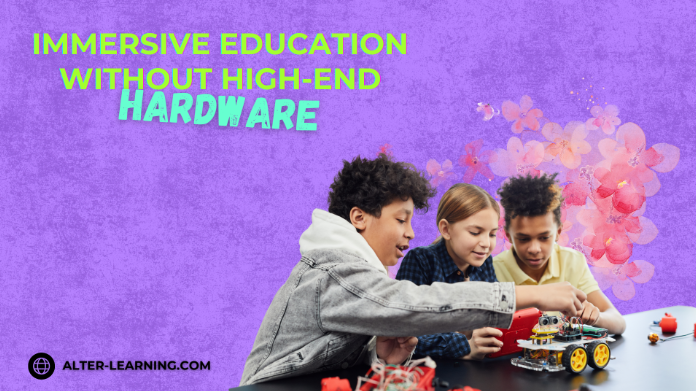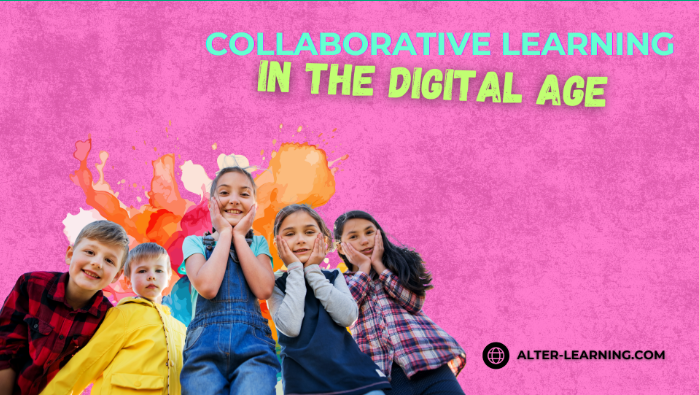The potential of immersive learning is often celebrated in the world of educational technology — but the conversation too frequently assumes access to top-tier hardware: VR headsets, high-spec PCs, or complex AR setups. In reality, many classrooms and families work with aging laptops, limited bandwidth, or shared devices.
That doesn’t mean immersive learning is out of reach. With careful design and thoughtful implementation, it can be possible to offer high-impact experiences without high-end tech, and that’s where Alter-Learning enters.
Immersion is less about technology than it is about experience. A learning environment becomes immersive when students are mentally and emotionally engaged — when they feel present in the subject matter and invested in the outcome. This can happen through a headset, yes, but it can also happen on a basic Chromebook or tablet if the content is designed with that intention.
Immersive educational platforms that don’t rely on cutting-edge devices can still offer:
- 360-degree educational videos that place learners in historical sites, scientific environments, or creative studios,
- Interactive VR simulations that can run on desktop with simple keyboard-and-mouse inputs,
- AR learning experiences that use smartphone cameras to layer content over real-world objects,
- Digital art creation tools and coding tutorials that emphasize creativity and problem-solving without requiring heavy processing power.
These options allow students to explore, interact, and learn in dynamic ways — even without expensive gear.
Bridging the Digital Divide Through Design
Equity in education isn’t just about having the latest tools. It’s about designing tools that work for as many learners as possible. Educational technology that can operate effectively on low-spec machines can help bridge the digital divide by expanding access to high-quality content.
Accessible platforms often include features such as:
- Web-based delivery with minimal installation or download requirements,
- Offline capability for schools with unreliable internet access,
- Low bandwidth modes with optimized visuals and compressed assets,
- Lightweight applications that run on older operating systems or shared school desktops.
When immersive learning is inclusive by design, it becomes a viable option for a broader spectrum of learners — regardless of their ZIP code or device inventory.
Supporting Teachers in Real-World Classrooms
Educators are often the first to see the potential of immersive tools — but also the first to run into limitations. Bandwidth bottlenecks, outdated devices, and tight instructional time can make tech implementation feel overwhelming. Platforms that don’t require a major tech overhaul can be a breath of fresh air.
Teachers working in typical environments may find value in platforms that:
- Run smoothly during live class sessions on school-issued laptops,
- Can be projected onto shared screens for whole-group participation,
- Allow students to work independently, at their own pace, without constant supervision,
- Integrate with LMS systems or classroom platforms they already use.
These features make immersive content easier to adopt, support, and scale — without needing a dedicated IT staff or infrastructure upgrade.
Designing for Depth, Not Just Dazzle
It’s easy to equate immersive learning with cinematic visuals or flashy interactions. But meaningful immersion comes from depth: well-structured content, opportunities for exploration, and tasks that challenge learners to think critically. Even simple interfaces can deliver complex ideas when they’re tied to purposeful design.
Well-designed low-tech immersive tools may include:
- Engineering challenges for students using simple mechanical concepts and visual logic,
- Science games for kids where learners simulate real-world systems like ecosystems or space environments,
- VR math games that emphasize spatial reasoning and applied problem-solving,
These experiences can provide all the benefits of immersive education — without putting a strain on a school’s technology resources.
The promise of immersive learning shouldn’t belong only to the best-funded classrooms. By designing tools that perform well on standard equipment, educational platforms can make powerful, interactive STEAM learning accessible to far more students. While headsets and next-gen devices have their place, effective immersion is a matter of design, not expense.
With the right approach, educators can offer their students the kind of learning that feels expansive, interactive, and inspiring — using the tools they already have. It’s not about scaling back ambition; it’s about making educational transformation scalable.
Follow Alter-Learning for more insights into immersive education, edtech success stories, and the future of learning. Want to explore how VR/AR could transform your school or learning platform? Let’s connect.




